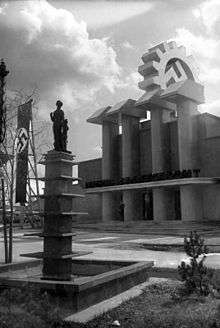Reactionary modernism

"Reactionary modernism" is a term first coined by Jeffrey Herf in his 1984 book, Reactionary Modernism: Technology, Culture and Politics in Weimar and the Third Reich, to describe the mixture of "great enthusiasm for modern technology with a rejection of the Enlightenment and the values and institutions of liberal democracy" which was characteristic of the German Conservative Revolutionary movement and Nazism.[1] In turn, this ideology of reactionary modernism was closely linked to the original, positive view of the Sonderweg, which saw Germany as the great Central European power neither of the West nor of the East.
Herf's application of the term to describe fascism has been widely echoed by other scholars.[2] Herf had used the term to denote a trend in intellectual thought during the era, what German novelist Thomas Mann had described as "a highly technological romanticism" during the interwar years. Herf used the term in reference to a wide range of German cultural figures, including Ernst Jünger, Oswald Spengler, Carl Schmitt, and Hans Freyer.
Reception of the concept
Historian Nicolas Guilhot has broadened the scope of reactionary modernism, applying the term to trends in Weimar Republic industry, medicine (eugenics), mass politics, and social engineering.[3] Reactionary modernism can be seen in the fascist concept of the New Man, as well as in art movements of Weimar culture that emphasized rationalism and embraced Futurism and the New Objectivity. Many Weimar period artists rejected the Futurists' fetishization of machinery and violence, for example the proponents of German Expressionism. Despite this, the return to order became a dominant theme in German culture and in that of other European countries.
Reactionary modernism has been explored as a theme in the interwar literature and broader political culture of Great Britain.[4] It has been examined in the context of other European countries during the interwar period, including Romania,[5] Greece,[6] Sweden,[7] and Spain.[8] It has even been examined in the context of fascism in Japan.[9] Other historians acknowledge the term's recognition of an influential trend in European philosophical, cultural and political thought during the period when fascism was on the rise.[10] Since the neologism was created by Herf, it has gained mainstream currency with historians in discussing the paradoxical European enthusiasm for paternalistic authoritarianism and volkish nationalism on the one hand, and new technological and political concepts on the other hand, all under totalitarian regimes.[11]
Herf now applies the term to claim similarity to the governments of Iran under the Ayatollahs, the government of Iraq under Saddam Hussein, and Islamist groups such as Al Qaeda.[1] Other scholars, including Paul Berman, have also applied Herf's term to Islamism.[12][13][14][15]
Cultural critic Richard Barbrook argues that members of the digerati, who adhere to the Californian Ideology, embrace a form of reactionary modernism which combines economic growth with social stratification.[16]
See also
References
- 1 2 The Totalitarian Present: Why the West Consistently Underplays the Power of Bad Ideas, Jeffrey Herf, The American Interest
- ↑ Mark Neocleous, Fascism, University of Minnesota Press, 1997, p. 60.
- ↑ Guilhot, Nicolas (2011). The Invention of International Relations Theory: Realism, the Rockefeller Foundation, and the 1954 Conference on Theory. Columbia University Press. pp. 213–4. ISBN 9780231152679.
- ↑ Zox-Weaver, Annalisa (2011). Women Modernists and Fascism. Cambridge University Press. pp. 7–8. ISBN 9781107008526.
- ↑ Cotoi, Calin (2009). "Reactionary Modernism in Interwar Romania: Anton Golopentia and the Geopoliticization of Sociology". In Tomasz Kamusella, Krzysztof Jaskułowski. Nationalisms Today. Peter Lang. p. 125. ISBN 9783039118830.
- ↑ Bien, Peter (1997). Greek Modernism and Beyond: Essays in Honor of Peter Bien. Rowman & Littlefield. pp. 96–100. ISBN 9780847685776.
- ↑ Pietikäinen, Petteri (2007). Neurosis and Modernity: The Age of Nervousness in Sweden. BRILL. p. 92. ISBN 9789004160750.
- ↑ Geoffrey Jensen, Irrational Triumph: Cultural Despair, Military Nationalism, and the Ideological Origins of Franco's Spain (Reno: University of Nevada Press, 2001), 4.
- ↑ Tansman, Alan (2009). The Culture of Japanese Fascism. Duke University Press. pp. 336–7. ISBN 9780822344681.
- ↑ Critchley, Simon (2001). Continental Philosophy: A Very Short Introduction. Oxford University Press. pp. N.p. ISBN 9780192853592.
- ↑ Van Dyke, James A. (2010). "Introduction: Reactionary Modernism and the Problem of Nazi Art". Franz Radziwill and the Contradictions of German Art History, 1919-45. University of Michigan Press. p. 1. ISBN 9780472116287.
- ↑ Power and the idealists, or, The passion of Joschka Fischer and its aftermath, Paul Berman, Soft Skull Press, 2005, p. 168.
- ↑ Fascism, Mark Neocleous, University of Minnesota Press, 1997, p. 2.
- ↑ New World Empire: Civil Islam, Terrorism, and the Making of Neoglobalism, William H. Thornton, Rowman & Littlefield, 2005, p. 74.
- ↑ Radical Islam: Medieval Theology and Modern Politics, Emmanuel Sivan, Yale University Press, 1990, p. 81.
- ↑ Barbrook, Richard (1999). "Cyber-Communism: How The Americans Are Superseding Capitalism In Cyberspace". Retrieved 2010-03-14.